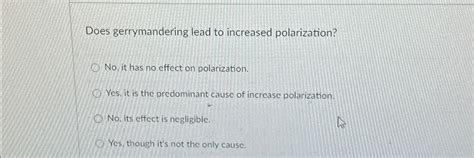Gerrymandering, the manipulation of electoral district boundaries for political advantage, has been a prevalent practice in the United States for centuries. In recent years, however, concerns have grown about the potential consequences of gerrymandering, particularly its impact on political polarization.

Gerrymandering and Political Polarization
Political polarization refers to the increasing division between opposing political viewpoints, resulting in a decline in consensus and cooperation. Gerrymandering contributes to this polarization by creating electoral districts that are not representative of the overall population.
By concentrating like-minded voters into a few districts, gerrymandering dilutes their representation in other districts. This leads to a situation where elected officials represent extreme ideological positions rather than the moderate views held by most voters.
Empirical Evidence
Numerous studies have found a correlation between gerrymandering and increased political polarization. For instance, a study published in the American Political Science Review showed that gerrymandering in the United States House of Representatives has resulted in a significant increase in polarization since the 1990s.
Consequences of Increased Polarization
Increased political polarization has detrimental consequences for society, including:
- Gridlock: Extreme partisan divides make it difficult for elected officials to find common ground and pass legislation.
- Division: Polarization can lead to social and political divisions, eroding trust and cooperation within communities.
- Radicalization: Gerrymandering can create echo chambers where voters are exposed to only one perspective, leading to further radicalization of beliefs.
Strategies to Address Gerrymandering
To mitigate the negative effects of gerrymandering, several strategies have been proposed:
- Independent Redistricting Commissions: Create independent commissions responsible for drawing electoral boundaries, free from partisan influence.
- Proportional Representation: Implement electoral systems that ensure representation of multiple parties based on their popular vote share.
- Anti-Gerrymandering Laws: Enact legislation that prohibits or limits gerrymandering practices.
Pros and Cons of Addressing Gerrymandering
Pros:
- Reduced political polarization
- More representative government
- Increased voter confidence
Cons:
- Potential for partisan bias in commission appointments
- Complexity of implementing proportional representation
- Challenges in proving gerrymandering in court
Frequently Asked Questions (FAQs)
1. Is gerrymandering a constitutional issue?
Yes, gerrymandering can be challenged under the Equal Protection Clause of the Fourteenth Amendment, which prohibits states from denying citizens the equal protection of the laws.
2. How common is gerrymandering in the United States?
Gerrymandering is widespread in both state and federal elections. According to the Brennan Center for Justice, partisan gerrymandering has occurred in 35 states since 2010.
3. What are the consequences of gerrymandering for voters?
Gerrymandering dilutes the political power of voters, making it more difficult for their voices to be heard. It also reduces competition and choice in elections.
4. Is gerrymandering reversible?
Yes, gerrymandering can be reversed through legal challenges, court orders, or changes in the electoral system.
5. What is a gerrymander?
A gerrymander is an electoral district whose shape or composition has been manipulated to favor a particular political party or candidate.
6. What is malapportionment?
Malapportionment occurs when the population of an electoral district differs significantly from the population of other districts, resulting in unequal representation.
Conclusion
Gerrymandering is a significant contributor to political polarization in the United States. By manipulating electoral boundaries, it creates districts that amplify extreme ideological positions and make it difficult for moderate voices to be heard. To address this issue, it is essential to implement strategies that promote independent redistricting, proportional representation, and anti-gerrymandering laws. Only through concerted efforts can we mitigate the negative consequences of gerrymandering and foster a more representative and inclusive democracy.
Additional Resources
- https://www.brennancenter.org/issues/ensure-every-american-can-vote/gerrymandering
- https://www.aclu.org/issues/voting-rights/gerrymandering
- https://www.fairvote.org/gerrymandering
